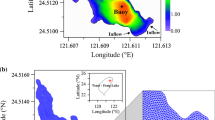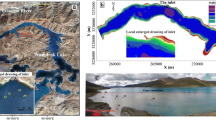Abstract
In shallow, wind exposed lakes, the light conditions, the cycling of nutrients, heavy metals and organic micro-pollutants and changes in the local composition of the sediment top layer can be dominated by resuspension/erosion of bottom sediment and sedimentation of suspended solids. A 2 dimensional model for Sediment Transport, Resuspension and Sedimentation in Shallow lakes (STRESS-2d), based on an existing transport model, is discussed. In the model, mass balance equations for the water compartment and the bottom sediment are solved numerically. Up to 7 sediment fractions can be taken into account, each having a specific set of resuspension/erosion and sedimentation parameter values. Several options for modelling the changes in the bottom sediment composition are available.
A simulation experiment for Lake Veluwe (The Netherlands), in which model options with and without the distinction of sediment fractions were used, showed that using sediment fractions to account for the variability in the sediment composition leads to an improvement of the model results, particularly the simulated phosphorus sediment-water exchange fluxes. For Lake Ketel (The Netherlands) two options for modelling changes in the bottom sediment composition are compared. It is shown that an option in which a thin water-sediment layer on top of the more consolidated bottom sediment is simulated provides an improvement in the simulation of the suspended solids concentration.
Similar content being viewed by others
References
Aalderink, R. H., L. Lijklema, J. Breukelman, W. van Raaphorst & A. G. Brinkman, 1984. Quantification of wind induced resuspension in a shallow lake. Wat. Sci. Tech. 17: 903–914.
Beurskens, J. E. M., Th. E. M. ten Hulscher & L. E. van der Velde, 1988. Microverontreinigingen; verspreiding van microverontreinigingen in IJssel, Ketelmeer & IJsselmeer. Rijkswaterstaat, Projectgroep Ketelmeer, Lelystad (The Netherlands).
Bouws, E., 1986. Verwachting van de zeegang door middel van groeicurves; bevindingen verkregen aan de hand van de Markermeer dataset. Koninklijk Nederlands Meteorologisch Instituut, Memo-00-86-33, De Bilt (The Netherlands).
Brinkman, A. G. & W. van Raaphorst, 1986. De fosfaathuishouding in het Veluwemeer. Thesis, Techn. Univ. of Twente, Enschede (The Netherlands).
CERC, 1977. Shore protection manual. United States Army Coastal Engineering Centre, Washington.
Kirk, J. T. O., 1983. Light and Photosynthesis in Aquatic Ecosystems. Cambridge University Press, Cambridge.
Lam, D. C. L. & J. H. Jaquet, 1976. Computations of physical transport and regeneration of phosphorus, fall 1970. J. Fish Res. Bd Can. 33: 550–563.
Lee, D. Y., W. Lick, S. W. Kang, 1981. The entrainment and deposition of fine-grained sediments in Lake Erie. J. Great Lakes Res. 7: 224–233.
Lick, W., 1982. Entrainment, deposition and transport of fine grained sediments in lakes. Hydrobiologia 91: 31–40.
Lijklema, L., R. A. Aalderink, G. Blom & E. H. S. Van Duin, 1991. Sediment transport in shallow lakes, two case studies related to sediment transport. In J. V. DePinto (ed.), Transport and transformation of contaminants near the sediment-water interface, Springer Verlag, New York (in press).
Luettich, R. A., 1987. Sediment resuspension in a shallow lake. Thesis, Massachusetts Inst. of Techn., Cambridge, Mass..
Phillips, O. M., 1966. The Dynamics of the Upper Ocean. Cambridge University Press, Cambridge.
Sheng, Y. P. & W. Lick, 1979. The transport and resuspension of sediments in a shallow lake. J. Geophys. Res. 84: 1809–1826.
Somlyòdy, L., 1980. Preliminary study on wind induced interaction between water and sediment for Lake Balaton (Scemes Basin). In G. van Straten, S. Herodek, J. Fisher & I. Kovacs (eds.), Proc. of the 2nd joint MTA/IIASA task force meeting on Lake Balaton modelling II. MTA-VEAB, Veszprém, Hungary: 26–49.
Stelling, G. S., 1984. On the construction of computational methods for shallow water flow problems. Rijkswaterstaat communications no. 35, The Hague (The Netherlands).
Van Duin, E. H. S., G. Blom, L. Lijklema & M. J. M. Scholten, 1992. Aspects of modelling sediment transport and light conditions in Lake Marken. Hydrobiologia 235/236: 167–176.
Author information
Authors and Affiliations
Rights and permissions
About this article
Cite this article
Blom, G., Van Duin, E.H.S., Aalderink, R.H. et al. Modelling sediment transport in shallow lakes — interactions between sediment transport and sediment composition. Hydrobiologia 235, 153–166 (1992). https://doi.org/10.1007/BF00026208
Issue Date:
DOI: https://doi.org/10.1007/BF00026208




